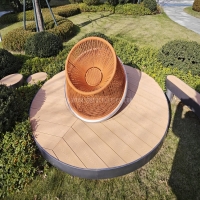Welcome to the website for landscape facilities products and knowledge.
How does the table’s surface finish resist common wear and tear, such as scratches or UV damage?
The durability of a table's surface finish depends on sophisticated protective technologies that combat daily wear challenges. Modern tables employ multiple defense mechanisms starting with hardened topcoats creating molecular barriers against physical abrasion. These coatings typically consist of polyurethane, epoxy, or ceramic-infused layers that absorb impact energy while distributing pressure across wider areas, preventing concentrated scratch formation.
For UV resistance, manufacturers integrate advanced light-stabilizing compounds within the finish matrix. These microscopic UV absorbers and hindered amine light stabilizers (HALS) work synergistically to neutralize ultraviolet radiation before it can break down chemical bonds in the coating or underlying material. This photochemical protection maintains color integrity and prevents the chalky appearance common in sun-exposed furniture.
The scratch resistance mechanism involves both hardness and elasticity principles. While harder surfaces like conversion varnishes resist penetration through cross-linked polymer networks, slightly flexible finishes like catalyzed lacquers allow minor deformations without permanent marking. Many premium finishes incorporate nano-ceramic particles that create sacrificial wear layers - these microscopic components absorb abrasion while maintaining the underlying surface integrity.
Environmental factors significantly influence finish performance. Temperature-stable resins prevent thermal expansion cracks, while moisture-resistant formulations block water vapor penetration that causes clouding or adhesion failure. Advanced manufacturing techniques like UV-curing create instant molecular bonds stronger than traditional air-dried finishes, resulting in seamless protective membranes.
Maintenance practices enhance inherent durability. Regular cleaning with pH-neutral solutions preserves protective qualities, while wax-free polishes maintain surface tension without compromising the finish's protective capabilities. Understanding these mechanisms empowers consumers to select tables with appropriate finish technologies for their specific environmental conditions and usage patterns, ensuring long-term preservation of both functional and aesthetic qualities.
Related search:

Recommendation
Swivel chair-Specialty steel structure woven rattan leisure chair with rotatable design